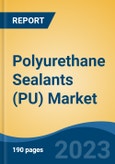Speak directly to the analyst to clarify any post sales queries you may have.
10% Free customizationThis report comes with 10% free customization, enabling you to add data that meets your specific business needs.
Among these, the construction industry continues to be a leading consumer, relying heavily on PU sealants for sealing joints, cracks, and expansion gaps in infrastructure and buildings. Urban development and infrastructure investments - particularly in emerging economies - are significantly boosting demand. Furthermore, the use of polyurethane sealants aligns with energy efficiency and green building initiatives, contributing to enhanced thermal insulation and compliance with low-VOC environmental standards. These qualities, combined with increasing sustainability goals and technological advancements, continue to drive the global PU sealants market forward.
Key Market Drivers
Growing Demand from the Construction Industry
The global polyurethane sealants market is experiencing strong growth, primarily fueled by escalating demand within the construction industry. Countries such as the United States and regions like Asia Pacific have shown consistent expansion in construction activities, with urbanization and infrastructure projects driving consumption of sealants. Polyurethane sealants are widely used in applications like sealing expansion joints, structural gaps, and curtain wall systems, offering exceptional adhesion to materials including concrete, metal, and wood.Their durability against UV exposure, weather conditions, and thermal fluctuations ensures long-term performance, reducing the need for frequent maintenance. In line with global efforts to improve building energy efficiency, PU sealants play a pivotal role in minimizing energy loss by sealing air gaps. With buildings contributing to approximately 37% of global CO₂ emissions and over 34% of total energy consumption, the role of PU sealants in green construction is more critical than ever. Their availability in low-VOC variants also supports sustainable construction practices, making them indispensable for developers aiming to meet regulatory and environmental benchmarks.
Key Market Challenges
Economic downturns and fluctuations
The global polyurethane sealants market faces notable challenges due to economic downturns and fluctuating market conditions. As the construction sector is a major end-user, economic recessions often lead to project postponements, funding limitations, and reduced activity - directly affecting demand for PU sealants. Financial instability can result in lower order volumes, surplus inventory, and pricing pressures for manufacturers, impeding growth strategies. Although polyurethane sealants are also used in other sectors such as automotive and industrial manufacturing, these industries may also experience downturns during economic contractions. Nevertheless, the diversified application base offers some degree of market resilience. Sustained growth in the PU sealants market, however, remains closely tied to the recovery and stability of global economic conditions, particularly in infrastructure-heavy regions.Key Market Trends
Utilization of Polyurethane Sealants in the Development of Self-Healing Materials
A key trend shaping the polyurethane sealants market is their integration into self-healing material technologies. These advanced materials can automatically repair damage such as cracks or surface wear, significantly enhancing the durability and lifespan of structures and components. In construction, self-healing sealants can maintain structural integrity over time by autonomously addressing minor failures, reducing long-term maintenance requirements. In sectors such as transportation and aerospace, this innovation enhances safety, performance, and cost-efficiency by preventing the escalation of minor damage. The development of PU-based self-healing materials marks a forward-thinking shift in product innovation, offering high-performance solutions for industries focused on long-term durability and reliability.Key Market Players
- Arkema SA
- Asian Paints Ltd.
- BASF SE
- Dow Inc.
- H.B. Fuller Company
- Henkel AG & Co KGaA
- Holcim Limited
- KCC Corporation
- Mapei S.p.A
- Pidilite Industries Limited
Report Scope:
In this report, the Global Polyurethane Sealants (PU) Market has been segmented into the following categories, in addition to the industry trends which have also been detailed below:Polyurethane Sealants (PU) Market, By Type:
- One-Component
- Two-Component
Polyurethane Sealants (PU) Market, By Application:
- Glazing
- Flooring & Joining
- Concrete Joints
- Submerged
- Sanitary & Kitchen
Polyurethane Sealants (PU) Market, By End-User:
- Building & Construction
- Automotive
- General Industrial
- Marine
- Aerospace
- Others
Polyurethane Sealants (PU) Market, By Region:
- Asia Pacific
- China
- India
- Japan
- Australia
- South Korea
- North America
- United States
- Canada
- Mexico
- Europe
- France
- United Kingdom
- Italy
- Germany
- Spain
- South America
- Brazil
- Argentina
- Colombia
- Middle East & Africa
- South Africa
- Saudi Arabia
- UAE
Competitive Landscape
Company Profiles: Detailed analysis of the major companies present in the Global Polyurethane Sealants (PU) Market.Available Customizations:
With the given market data, the publisher offers customizations according to a company's specific needs. The following customization options are available for the report.Company Information
- Detailed analysis and profiling of additional market players (up to five).
This product will be delivered within 1-3 business days.
Table of Contents
Companies Mentioned
- Arkema SA
- Asian Paints Ltd.
- BASF SE
- Dow Inc.
- H.B. Fuller Company
- Henkel AG & Co KGaA
- Holcim Limited
- KCC Corporation
- Mapei S.p.A
- Pidilite Industries Limited
Table Information
| Report Attribute | Details |
|---|---|
| No. of Pages | 185 |
| Published | June 2025 |
| Forecast Period | 2024 - 2030 |
| Estimated Market Value ( USD | $ 2.93 Billion |
| Forecasted Market Value ( USD | $ 3.73 Billion |
| Compound Annual Growth Rate | 4.3% |
| Regions Covered | Global |
| No. of Companies Mentioned | 10 |









